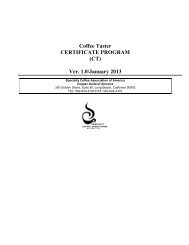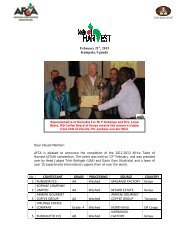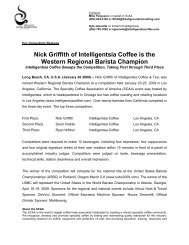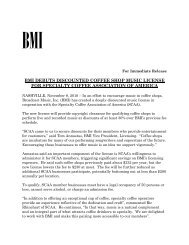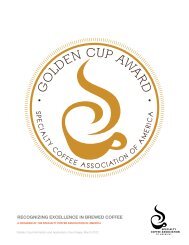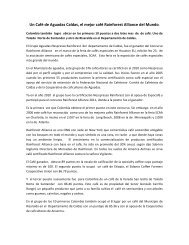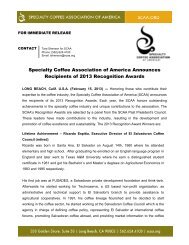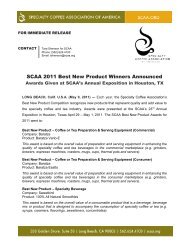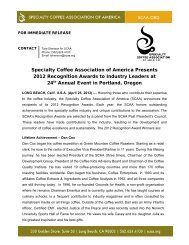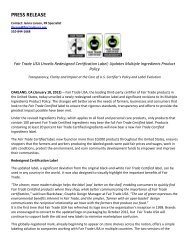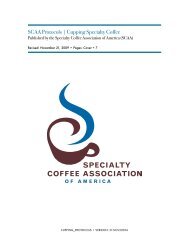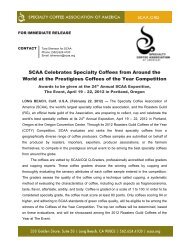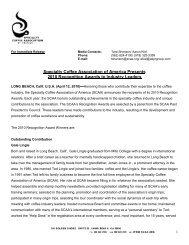SCAA Laboratory | Requirements for Certification
SCAA Laboratory | Requirements for Certification
SCAA Laboratory | Requirements for Certification
You also want an ePaper? Increase the reach of your titles
YUMPU automatically turns print PDFs into web optimized ePapers that Google loves.
<strong>SCAA</strong> <strong>Laboratory</strong> | <strong>Requirements</strong> <strong>for</strong> <strong>Certification</strong><br />
Published by the Specialty Coffee Association of America (<strong>SCAA</strong>)<br />
Developed by:<br />
Statistics & Standards Committee • Revised: October 27, 2009 • Pages: Cover + 4<br />
LAB_CERT_REQUIREMENTS • VERSION: 27OCT2009A
<strong>SCAA</strong> <strong>Laboratory</strong> | <strong>Requirements</strong> <strong>for</strong> <strong>Certification</strong><br />
Purpose<br />
This document outlines the minimum requirements necessary to achieve a successful <strong>SCAA</strong><br />
<strong>Laboratory</strong> <strong>Certification</strong>, which will enable the lab to become certified to administer the <strong>SCAA</strong><br />
Cupping Judge Course.<br />
Lab Environment <strong>Requirements</strong><br />
Cupping Rooms & Classroom<br />
Lighting<br />
<strong>SCAA</strong> Certified Labs must have a cupping room/classroom big enough to<br />
accommodate at least one cupping table (maximum of six cuppers per table) and<br />
additional furniture to per<strong>for</strong>m the rest of the testing required.<br />
Room Dimensions | Room should be no smaller than 110 sq ft (10.2 sq. meters). Tables<br />
should be at least 5 ft by 2 ft with a height of 42 to 46 inches. The dimensions of the room<br />
should be com<strong>for</strong>table, allowing <strong>for</strong> 3 feet of free space around the cupping table.<br />
Cupping rooms that are larger than the dimensions specified above are allowed.<br />
Classroom should be able to accommodate at least the same number of students as the<br />
cupping tables. The cupping room may double as a classroom, but there should be a<br />
distinct area <strong>for</strong> students to per<strong>for</strong>m the required testing.<br />
The roasting in this facility should be done in a separate room so that it does not<br />
interfere with classes that are in session.<br />
Type | Full spectrum light source to achieve the following light parameters: minimum<br />
of 4.000 Kelvin (measure intensity of color) / 1200 LUX (measure light cast on a surface<br />
of 1 sq. meter) / 120 FTC (Foot Candles measure the light cast on 1 sq. ft). Replace light<br />
bulbs accordingly to maintain the above retention indexes. A controlled light is<br />
preferable over a natural daylight, unless the vast majority of cupping days have no<br />
variation in light intensity. Labs that use natural light will have to show a yearly<br />
meteorological report which shows spec conditions are met.<br />
Lighting <strong>Requirements</strong> | Some of the testing will require a dark environment. Labs<br />
should be equipped with window shades to darken the environment as needed. To<br />
per<strong>for</strong>m these tests, the lab should also be equipped with red lights (or blue) over the<br />
tables capable of masking the color differences of the coffee in the cups.<br />
LAB_CERT_REQUIREMENTS • VERSION: 27OCT2009A 1 of 4
<strong>SCAA</strong> <strong>Laboratory</strong> | <strong>Requirements</strong> <strong>for</strong> <strong>Certification</strong><br />
Ventilation<br />
Special Table-Top Lighting Fixtures | To grade green coffee, a special light and<br />
certain conditions are required. See the Green Coffee Color Assessment document <strong>for</strong><br />
more details.<br />
Controlled | Ideally, air conditioning or alternative system as an Evaporative Cooling<br />
System. It is important that the air movement is not so strong that will disturb the<br />
smelling of the aroma during cupping or the act of smelling during other exercises. If<br />
such disturbances occur, the AC or alternative air system should be temporarily shut off<br />
until that specific part of the exercise or test is over.<br />
Pleasant | Temperature inside cupping rooms should be pleasant with temperature<br />
range within 68˚ to 86˚ Fahrenheit and R.H. not to exceed 85%. Room should be free of<br />
“hot spots”.<br />
Environment<br />
No odors | No strange odors are allowed, food, perfumes, smoke, etc.<br />
No phones | No phones should be present, or they should be in a DND (Do not<br />
disturb) mode so that cupping and other exercises can take place uninterrupted.<br />
No noise | “No noise” environment is required. External noise should be minimal,<br />
muffled or non existent. Cars, airplanes, working machinery, people and other noises,<br />
should be down to a level where they will not interfere with the cuppers work at hand.<br />
No distractions | The room itself should be “clean.” Too much clutter like machines<br />
and other lab apparatus should be displayed in the room in an orderly fashion to not<br />
interfere with the cupping. No visitors are allowed in class but will be allowed in a “view<br />
area.” Visitor’s presence is absolutely restricted during the course testing. Other<br />
“visitors” (like insects) should be kept out of the lab.<br />
Color | Lab walls and ceiling should be painted of a light color. White or light<br />
“calming” colors, i.e. light washed greens / yellows / blues.<br />
Closed Captioned Video System | A video camera is required in each room where<br />
instruction and tests take place. Video stream shall be connected to the internet and<br />
delivered immediately as high quality picture at 30 frames per second. One-way voice<br />
feed is required. No recording is necessary or allowed. Cameras should be installed near<br />
the ceiling to ensure that viewers can see the students in full. They should be focused on<br />
LAB_CERT_REQUIREMENTS • VERSION: 27OCT2009A 2 of 4
<strong>SCAA</strong> <strong>Laboratory</strong> | <strong>Requirements</strong> <strong>for</strong> <strong>Certification</strong><br />
the tables and areas being used by the students, as opposed to areas of the room that are<br />
not in use.<br />
Lab Materials <strong>Requirements</strong><br />
The following materials are required to pass the <strong>SCAA</strong> Lab <strong>Certification</strong> and to teach the <strong>SCAA</strong><br />
Cupping Judge Course.<br />
Sample Roaster | Needs to be able to roast coffee within the parameters of the <strong>SCAA</strong><br />
guidelines. Please see <strong>SCAA</strong> Cupping Protocols. Batch size should accommodate the number of<br />
students the lab is being certified <strong>for</strong>.<br />
Grinder | Needs to be able to grind meeting <strong>SCAA</strong> parameters <strong>for</strong> grind particle size. Need to<br />
be able to per<strong>for</strong>m within a 10% margin of difference from grind to grind using the same coffee.<br />
Colorimeter | Need to be able to identify roasted coffee color and compare with the <strong>SCAA</strong>/<br />
Agtron Roast Color Identification Scale. Different technologies can be used to achieve this<br />
measurement: refraction wave-length in a near infra-red <strong>for</strong>mat; true color measurement; etc. If<br />
different than an Agtron Machine a correlation needs to be established to the Agtron scale at a<br />
minimum of 95% confidence level.<br />
Water Treatment | Need to be able to produce water that meets <strong>SCAA</strong> specifications <strong>for</strong><br />
ideal water quality <strong>for</strong> cupping. Bottled water that meets the <strong>SCAA</strong> standards is acceptable.<br />
Hot Water | Need to be able to heat an adequate amount of water proportional to the number<br />
of cuppers <strong>for</strong> which the lab is being certified. Water needs to meet <strong>SCAA</strong> Cupping Protocols <strong>for</strong><br />
temperature.<br />
Cups | Different recipients can be use to cup coffee: glass (tempered) or ceramic materials are<br />
acceptable. Recommended cup size is a five or six fluid ounce, where all cups used are of<br />
identical volume, dimensions and material of manufacture. Tempered glass and or ceramic cups<br />
should have a diameter of at least 3” to 3.5”. <strong>SCAA</strong> Cupping Protocols should be followed to use<br />
the correct amount of ground coffee to match the respective recipient dimension and obtain the<br />
ideal extraction.<br />
Cupping Spoons | Recommended spoon should be able to take 4 to 5 ml of coffee sample<br />
and ideally should be silver plated <strong>for</strong> better heat dissipation. Silver-plated spoon should be of<br />
sufficient purity not to add any off flavors to the coffee.<br />
Cupping Forms | Need to follow the <strong>SCAA</strong> Approved Cupping Form <strong>for</strong>mat. Forms can be<br />
paper or electronic <strong>for</strong>mat.<br />
LAB_CERT_REQUIREMENTS • VERSION: 27OCT2009A 3 of 4
<strong>SCAA</strong> <strong>Laboratory</strong> | <strong>Requirements</strong> <strong>for</strong> <strong>Certification</strong><br />
Spittoons | Any recipient able to contain the cupper’s expectoration is acceptable. Smaller<br />
stainless steel containers are easier to deal with <strong>for</strong> cleaning purposes.<br />
Lighting | One set of lights per every four students is required.<br />
Le Nez du Café | Two sets of vials of Le Nez du Café are necessary per 6 students (Le Nez<br />
du Café sets to be used in testing need to be replaced every two years)<br />
One set of The Art of Aroma - Perception in Coffee four-poster set<br />
One set of the recommended <strong>SCAA</strong> Organic Acids<br />
<strong>SCAA</strong> Green Arabica Coffee Grading Classification System (poster)<br />
Black surface Grading Mats, plastic or paper is fine (one per student is required)<br />
<strong>SCAA</strong> Arabica Green Coffee Defect Handbook (one per student is required)<br />
<strong>SCAA</strong> Grading Protocols | Documents available at www.scaa.org<br />
Specialty Standard <strong>for</strong> Arabica Coffee | Green Coffee Quality<br />
Specialty Standard | Green Coffee Color Assessment<br />
Specialty Standard | Cupping Protocols<br />
Recommended: Coffee Taster’s Flavor Wheel poster (not required)<br />
All specified equipment is to be maintained up to <strong>Certification</strong> Standards. In the<br />
occurrence of a malfunction, this problem needs to be remedied be<strong>for</strong>e the next class<br />
is given. No further classes will be held until the lab can demonstrate that the problem<br />
has been resolved.<br />
LAB_CERT_REQUIREMENTS • VERSION: 27OCT2009A 4 of 4



